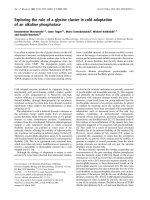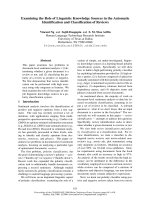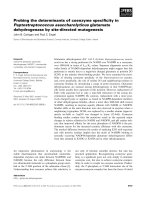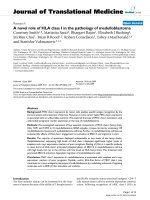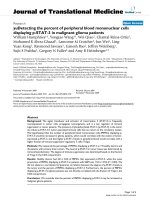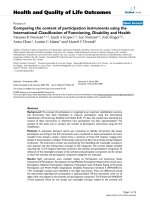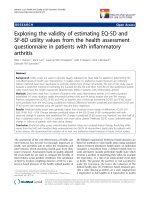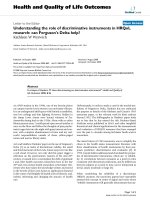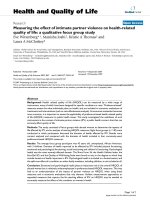báo cáo hóa học:" Re-evaluating the role of natural killer cells in innate resistance to herpes simplex virus type 1" pot
Bạn đang xem bản rút gọn của tài liệu. Xem và tải ngay bản đầy đủ của tài liệu tại đây (949.45 KB, 15 trang )
BioMed Central
Page 1 of 15
(page number not for citation purposes)
Virology Journal
Open Access
Research
Re-evaluating the role of natural killer cells in innate resistance to
herpes simplex virus type 1
William P Halford*
1
, Jennifer L Maender
2
and Bryan M Gebhardt
3
Address:
1
Dept of Veterinary Molecular Biology, Montana State University, Bozeman, MT, USA,
2
Dept of Dermatology, Baylor College of Medicine,
Houston, TX, USA and
3
Dept of Ophthalmology, Louisiana State University Health Sciences Center, New Orleans, LA USA
Email: William P Halford* - ; Jennifer L Maender - ; Bryan M Gebhardt -
* Corresponding author
Abstract
Background: Interferon-γ acts to multiply the potency with which innate interferons (α/β)
suppress herpes simplex virus type 1 (HSV-1) replication. Recent evidence suggests that this
interaction is functionally relevant in host defense against HSV-1. However, it is not clear which
WBCs of the innate immune system, if any, limit HSV-1 spread in an IFN-γ dependent manner. The
current study was initiated to determine if natural killer (NK) cells provide innate resistance to
HSV-1 infection, and if so to determine if this resistance is IFN-γ-dependent.
Results: Lymphocyte-deficient scid or rag2
-/-
mice were used to test four predictions of the central
hypothesis, and thus determine if innate resistance to HSV-1 is dependent on 1. NK cell
cytotoxicity, 2. NK cells, 3. WBCs, or 4. the IFN-activated transcription factor, Stat 1. Loss of NK
cell cytotoxic function or depletion of NK cells had no effect on the progression of HSV-1 infection
in scid mice. In contrast, viral spread and pathogenesis developed much more rapidly in scid mice
depleted of WBCs. Likewise, loss of Stat 1 function profoundly impaired the innate resistance of
rag2
-/-
mice to HSV-1.
Conclusion: Lymphocyte-deficient mice possess a very tangible innate resistance to HSV-1
infection, but this resistance is not dependent upon NK cells.
Background
Severe infections with herpesviruses such as herpes sim-
plex virus type 1 (HSV-1) have been observed in natural
killer (NK) cell-deficient individuals [1-3]. This observa-
tion has fostered the belief that NK cells play a central role
in innate resistance to HSV-1 infection. This hypothesis is
further supported by the mechanism of action of the viral
ICP47 protein. ICP47 binds the cellular antigen trans-
porter, TAP1, and thus prevents MHC class I molecules
from being transported to the surface of HSV-1 infected
cells [4]. This inhibition of MHC class I transport appears
to explain the long recognized fact that HSV-1 infection
renders cultured cells vulnerable to NK cell-mediated lysis
[5-7]. Indeed, expression of ICP47 is sufficient, in and of
itself, to downregulate MHC class I and induce NK cell-
mediated lysis of human cells [8]. Numerous in vitro and
in vivo studies also support the tenet that NK cells play an
integral role in innate resistance to HSV-1 infection [9-
13].
Against this background, it is not surprising that most cur-
rent texts and reviews indicate that NK cells are essential
for host resistance to HSV-1 infection [14-18]. However,
this tenet is based upon equivocal evidence. A handful of
Published: 17 July 2005
Virology Journal 2005, 2:56 doi:10.1186/1743-422X-2-56
Received: 05 May 2005
Accepted: 17 July 2005
This article is available from: />© 2005 Halford et al; licensee BioMed Central Ltd.
This is an Open Access article distributed under the terms of the Creative Commons Attribution License ( />),
which permits unrestricted use, distribution, and reproduction in any medium, provided the original work is properly cited.
Virology Journal 2005, 2:56 />Page 2 of 15
(page number not for citation purposes)
animal studies from the last 25 years indicate that NK cells
are not essential for host resistance to HSV-1 [19-21].
More recently, a similar conclusion was reached based on
the comparison of HSV-1 infection in rag2
-/-
mice versus
rag2
-/-
γ
c
-/-
mice [22]. However, loss of γ
c
not only prevents
NK cell development, but also renders mice null for the
function of interleukins (IL)-2,-4,-7,-9,-15, and -21. Given
its pleiotropic effects [23-25], the γ
c
-/-
mutation does not
provide a compelling basis for drawing inferences about
any one component of the innate immune system.
Numerous NK cell studies are confounded by similar
caveats. For example, NK cell depletion has been found to
impair host resistance to HSV-1 infection [12,26], but
activated T cells also express ''NK cell'' markers [27].
Therefore, the effect of anti-asialo GM1 and anti-NK1.1
antibodies on host resistance to HSV-1 may be due, at
least in part, to their capacity to blunt the T cell response
to viral infections [27].
Interferon (IFN)-γ multiplies the potency with which the
innate IFNs, IFN-α and/or IFN-β, suppress HSV-1 replica-
tion [28]. This cooperative inhibition by IFN-α/β and
IFN-γ effectively prevents virus-infected cells from synthe-
sizing new HSV-1 virions [29]. The profoundly accelerated
rate of HSV-1 spread in receptor-deficient mice suggests
that the interaction between the IFN-α/β-and IFN-γ-sign-
aling pathways is functionally relevant in innate resistance
to HSV-1 [22,30]. Consistent with this hypothesis, IFN-γ
expression is evident in HSV-1 infected tissues just 24
hours post inoculation (p.i.; Fig. 7 of Ref. [31]). T cells, NK
cells, and professional antigen-presenting cells (APCs) are
the primary IFN-γ-producers in the body [32,33]. CD8
+
T
cells play a major role in immune surveillance of HSV-1
latently infected ganglia, and can directly suppress HSV-1
reactivation in neurons in a manner that is MHC class I-
restricted and IFN-γ-dependent [34-38]. However, it is
unknown if NK cells and/or professional APCs confer
innate resistance to HSV-1 infection via the secretion of
IFN-γ at early times p.i.
The following study was initiated to determine if NK cells
provide innate resistance to HSV-1 infection via their
capacity to rapidly deliver IFN-γ to sites of viral replica-
tion. Scid or rag2
-/-
mice were used to test four predictions
that follow from this central hypothesis. Specifically,
experiments were performed to determine if innate resist-
ance to HSV-1 is dependent on 1. NK cell cytotoxicity, 2.
NK cells, 3. WBCs, or 4. the IFN-activated transcription
factor, Stat 1 [39,40]. The use of lymphocyte-deficient
mice assured that this analysis of innate resistance was not
confounded by the dominant effects of the adaptive
immune response. The results demonstrate that although
scid and rag2
-/-
mice possess a measurable resistance to
HSV-1, this innate resistance is not dependent upon NK
cells.
Results
Immune status of BALB/c scid mice
Lymphocyte maturation is not completely blocked in
some strains of scid mice [41-43]. Thus, B and T lym-
phocyte function were evaluated in scid mice. Assessment
of B cell function indicated that BALB/c mice had serum
IgG levels of 6.4 ± 1.3 mg/ml, whereas serum IgG was
undetectable in scid mice (Fig. 1A). Flow cytometric anal-
ysis indicated that BALB/c mice contained an average 110
million WBCs per spleen, of which 21% were CD4
+
T
cells, 10% were CD8
+
T cells, and 2.5% were CD3
-
CD49b
+
NK cells (Fig. 1B). In contrast, scid mice con-
tained an average 8 million WBCs per spleen, of which
<0.1% were CD4
+
or CD8
+
T cells and 45% were CD3
-
CD49b
+
NK cells (Fig. 1B).
Adoptive transfer was performed to verify that adaptive
resistance to HSV-1 could be restored to scid mice. Follow-
ing ocular inoculation with HSV-1 strain KOS, scid mice
shed high titers of virus between 1 and 7 days p.i. (Fig.
1C). On day 7 p.i., scid mice were i.v. administered either
a. vehicle, b. total WBCs, c. purified B cells, or d. purified
T cells from naïve BALB/c donors (Fig. 1C). Vehicle-
treated scid mice continued to shed high levels of virus
(Fig. 1C) and succumbed to the infection within 17 ± 2
days p.i. (Fig. 1D). Scid mice reconstituted with total
WBCs shed 30-fold less virus than vehicle-treated controls
on day 14 p.i. (Fig. 1C) and 8 of 8 survived the infection
(Fig. 1D). Scid mice reconstituted with purified B cells
eventually died, but the mean time of survival was
increased to 22 ± 3 days (Fig. 1D). Reconstitution with
purified T cells controlled HSV-1 infection in 8 of 8 scid
mice, but viral shedding continued for ~3 days longer
than scid mice reconstituted with total WBCs (Fig. 1C).
Thus, all measures indicated that scid mice are effectively
devoid of B and T lymphocyte function.
Innate resistance to HSV-1 is not dependent on NK cell
cytotoxicity
To determine if innate resistance to HSV-1 is dependent
on NK cell cytotoxic function, infection with HSV-1 strain
KOS was compared in BALB/c scid mice versus non-obese
diabetic (NOD) scid mice. Consistent with previous
reports [44,45], WBCs isolated from the spleens of NOD
scid mice were functionally deficient in NK cell cytotoxic
activity relative to BALB/c mice and BALB/c scid mice (Fig.
2A). Following ocular inoculation with 2 × 10
5
pfu/eye,
HSV-1 strain KOS replicated to high and equivalent titers
in BALB/c scid mice and NOD scid mice between 1 and 14
days p.i. (not shown). No differences were observed in the
progression of viral pathogenesis or the duration of sur-
vival of BALB/c scid mice versus NOD scid mice (Fig. 2B).
Flow cytometry demonstrated that approximately one-
third of the peripheral WBCs of NOD scid mice possessed
the CD3
-
CD49b
+
phenotype of NK cells (Fig. 2C) [46,47].
Virology Journal 2005, 2:56 />Page 3 of 15
(page number not for citation purposes)
Immune status of BALB/c scid miceFigure 1
Immune status of BALB/c scid mice. A. ELISA measurement of serum IgG levels in BALB/c and BALB/c scid mice (n = 5
per group; dashed line denotes lower limit of detection). B. Flow cytometric measurement of the abundance of CD4
+
T cells,
CD8
+
T cells, and CD3
-
CD49b
+
NK cells in the spleens of BALB/c versus scid mice (n = 10 per group). "Other WBCs" refers
to the fraction of spleen cells not labeled by antibodies against CD3, CD4, CD8, and CD49b. C and D. Effect of adoptively
transferred naïve lymphocytes on scid mouse resistance to HSV-1. C. Viral titers per eye (dashed line denotes lower limit of
detection) and D. duration of survival of scid mice inoculated with 2 × 10
5
pfu/eye HSV-1 strain KOS. On day 7 p.i., scid mice (n
= 8 per group) received an i.v. injection of medium (vehicle) or medium containing 5 × 10
6
B cells, T cells, or unfractionated
WBCs (total WBCs) obtained from naïve BALB/c donors.
Virology Journal 2005, 2:56 />Page 4 of 15
(page number not for citation purposes)
Innate resistance to HSV-1 is not dependent on NK cell cytotoxicityFigure 2
Innate resistance to HSV-1 is not dependent on NK cell cytotoxicity. A. Cytotoxic activity of WBCs from BALB/c,
BALB/c scid, or NOD scid mice, as determined by percent maximum
51
Cr release achieved when 10
4
YAC-1 (target) cells were
incubated with 250,000 spleen WBCs (n = 3 per group). B. Duration of survival of BALB/c scid mice and NOD scid mice fol-
lowing ocular inoculation with 2 × 10
5
pfu/eye HSV-1 strain KOS (n = 5 per group). C. NK cell frequency in the spleens of
BALB/c, BALB/c scid, or NOD scid mice (n = 2 per group).
Virology Journal 2005, 2:56 />Page 5 of 15
(page number not for citation purposes)
Thus, despite the lack of in vitro cytotoxic activity (Fig. 2A),
NOD scid mice still possessed significant numbers of NK
cells that could control HSV-1 infection via other mecha-
nisms (e.g., IFN-γ secretion).
Innate resistance to HSV-1 is not dependent on NK cells
Preliminary experiments indicated that two treatments
with 0.32 or 1.0 mg rabbit anti-asialo GM1 reduced the
number of NK cells in BALB/c scid mouse spleens by >10-
and >50-fold, respectively, whereas control rabbit IgG
produced no such effect (Fig. 3). Thus, anti-asialo GM1
antibody was used to determine if NK cells are necessary
for innate resistance to HSV-1.
BALB/c mice and BALB/c scid mice were treated with PBS,
control IgG, or anti-asialo GM1 and were inoculated with
2 × 10
5
pfu/eye of HSV-1 strain KOS. In BALB/c mice, KOS
replicated to similar viral titers in mice treated with PBS,
control rabbit IgG, or anti-asialo GM1, with one notable
exception (Fig. 4A). On days 5 and 7 p.i., BALB/c mice
treated with rabbit anti-asialo GM1 shed ~5-fold more
virus than PBS-treated controls (Fig. 4A; p < 0.05, denoted
by asterisks). Between days 9 and 14 p.i., viral shedding
was detected in none of the BALB/c mice (Fig. 4A). Like-
wise, viral pathogenesis was limited, and 100% of BALB/c
mice survived infection with HSV-1 strain KOS (Fig. 4B).
BALB/c scid mice shed infectious KOS continuously dur-
ing the 14-day sampling period (Fig. 4A). Treatment with
rabbit anti-asialo GM1 had no effect on the titers of infec-
tious KOS recovered from the eyes of BALB/c scid mice
between 1 and 14 days p.i. (Fig. 4A). Scid mice treated
with PBS survived for 16 ± 1 days p.i. (Fig. 4B). Treatment
with rabbit anti-asialo GM1 did not shorten the duration
of survival of KOS-infected scid mice (Fig. 4B). Paradoxi-
cally, treatment with rabbit anti-asialo GM1 or control
rabbit IgG increased the duration of survival of KOS-
infected BALB/c scid mice to 24 ± 1 and 35 ± 3 days p.i.,
respectively (Fig. 4B; p <0.001). Multiple experiments
confirmed this unexpected effect that rabbit immu-
noglobulin (with no reactivity against HSV-1) prolonged
the survival of KOS-infected scid mice. The interpretation
of these data was complicated by this caveat. However, it
was clear that NK cell depletion did not fundamentally
alter the progression of HSV-1 infection in scid mice dur-
ing the first week p.i.
Innate resistance to KOS is dependent on peripheral WBCs
Cyclophosphamide (CyP) is an alkylating agent that is
rapidly converted in vivo into metabolites that cause lethal
DNA damage in dividing cells [48,49], and transiently
reduce peripheral WBC counts by ~90% in mice [31]. To
determine if WBCs are necessary for innate resistance to
HSV-1, BALB/c mice and scid mice were treated with PBS
Efficacy of NK cell depletion with anti-asialo GM1 antibodyFigure 3
Efficacy of NK cell depletion with anti-asialo GM1 antibody. The frequency of CD3
-
CD49b
+
NK cells in the spleens of
A. BALB/c mice and B. BALB/c scid mice that received i.p. injections of 1.0 mg per day control rabbit IgG, as compared to scid
mice treated with C. 0.32 or D. 1.0 mg per day of rabbit anti-asialo GM1. Mice were treated with antibody on Days 0 and 3,
and spleen WBCs were isolated on Day 4 for flow cytometric analysis with FITC-labeled anti-CD3 and PE-labeled anti-CD49b.
The frequency of NK cells (upper left quadrant) and CD3
+
T cells are indicated on each graph. Results are representative of
three independent experiments.
Virology Journal 2005, 2:56 />Page 6 of 15
(page number not for citation purposes)
or CyP and were inoculated with 2 × 10
5
pfu/eye of HSV-
1 strain KOS. On day 4 p.i., peripheral WBC counts
(WBCs per ml × 10
6
) in each group were, as follows:
BALB/c + PBS = 6.6 ± 0.5; scid + PBS = 2.3 ± 0.2; BALB/c +
CyP = 0.8 ± 0.1; and scid + CyP = 0.4 ± 0.1. Similar viral
titers were recovered from the eyes of all mice at 24 hours
p.i. (Fig. 5A). However, BALB/c mice treated with CyP
shed 30- to 1000-fold more virus than PBS-treated BALB/
c mice between 5 and 9 days p.i. (Fig. 5A; p < 0.05,
denoted by asterisks). Likewise, CyP-treated scid mice
shed 2- to 7-fold more virus than PBS-treated scid mice
between 5 and 9 days p.i. (Fig. 5A). Viral titers were not
determined in CyP-treated mice on 11 and 14 days p.i.
because the extent of ocular pathogenesis precluded a reli-
able measurement.
BALB/c mice treated with PBS uniformly survived ocular
HSV-1 infection (Fig. 5B). In contrast, 0% of CyP-treated
BALB/c mice survived HSV-1 infection (Fig. 5B). The
death of these mice was not a direct consequence of CyP's
toxicity, because 100% of uninfected BALB/c controls sur-
vived the same course of CyP treatment (Fig. 5B). PBS-
treated scid mice survived ocular inoculation with HSV-1
strain KOS for 18 ± 1 days (Fig. 5C). In contrast, CyP-
treated scid mice succumbed to HSV-1 infection within 12
± 1 days (Fig. 5C; p < 0.001). This reduced duration of sur-
vival was not a direct consequence of CyP's toxicity,
Effect of NK cell depletion on innate resistance to HSV-1Figure 4
Effect of NK cell depletion on innate resistance to HSV-1. BALB/c mice and BALB/c scid mice, inoculated with 2 × 10
5
pfu/eye HSV-1 strain KOS, received i.p. injections of PBS, control IgG or anti-asialo GM1 (1.2 mg) on days -1, 2, 4, 6, 8 and 10
p.i. A. Viral replication in the eyes of BALB/c mice and scid mice treated with PBS, control IgG or anti-asialo GM1 (mean ±
SEM; n = 9; dashed line denotes lower limit of detection). Asterisks denote times at which anti-asialo GM1-treated BALB/c
mice shed more virus than PBS-treated BALB/c mice (p < 0.05, ANOVA and Tukey's post hoc t-test). B. Duration of survival
of HSV-1 infected BALB/c mice and scid mice treated with PBS, control IgG or anti-asialo GM (n = 9 per group).
Virology Journal 2005, 2:56 />Page 7 of 15
(page number not for citation purposes)
Effect of WBC depletion on innate resistance to HSV-1Figure 5
Effect of WBC depletion on innate resistance to HSV-1. BALB/c mice and BALB/c scid mice, inoculated with 2 × 10
5
pfu/eye HSV-1 strain KOS, received i.p. injections of PBS or cyclophosphamide (CyP; 125 mg/kg) on days -1, 1, and 3 p.i. Unin-
fected BALB/c mice and uninfected scid mice received i.p. injections of CyP at the same time points (n = 8 per group). A. Viral
replication in the eyes of BALB/c mice and scid mice treated with PBS or CyP (mean ± SEM; n = 8; dashed line denotes lower
limit of detection). Asterisks denote times at which CyP-treated BALB/c mice shed more virus than PBS-treated BALB/c mice
(p < 0.05, ANOVA and Tukey's post hoc t-test). B and C. Duration of survival of HSV-1 infected B. BALB/c mice and C. scid
mice treated with PBS or CyP versus uninfected, CyP-treated controls (n = 8 per group).
Virology Journal 2005, 2:56 />Page 8 of 15
(page number not for citation purposes)
because 7 of 8 uninfected scid mice survived CyP treat-
ment (Fig. 5C). Therefore, depletion of total WBCs in scid
mice was correlated with decreased innate resistance to
HSV-1 infection.
Effect of NK cell versus WBC depletion on innate
resistance to HSV-1
The innate resistance of scid mice to HSV-1 infection was
not adversely affected by NK cell depletion, but was
impaired by CyP-induced depletion of total WBCs (Table
I). To assure that inter-experimental variance was not the
source of these differences, the effect of NK cell versus
total WBC depletion was directly compared in scid mice
infected with KOS-GFP, a GFP-expressing recombinant
virus [50]. Scid mice were treated with PBS, rabbit IgG,
anti-asialo GM1, or CyP and were inoculated with 2 × 10
5
pfu/eye HSV-1 strain KOS-GFP. GFP expression provided
a measure of the extent of KOS-GFP spread in scid mice
(Fig. 6A). Anti-asialo GM1 antibody treatment caused a
>20-fold reduction in NK cell abundance, as determined
in n = 2 KOS-GFP-infected scid mice sacrificed on day 5 p.i
Despite effective depletion of NK cells, neither treatment
with control rabbit IgG nor anti-asialo GM1 had a meas-
urable effect on KOS-GFP spread in the eyes or periocular
skin of scid mice during the first 6 days p.i. (Fig. 6A). In
contrast, CyP treatment enhanced the spread of KOS-GFP
into the periocular skin of scid mice on day 6 p.i. relative
to the other treatment groups (Fig. 6A).
PBS-treated scid mice infected with HSV-1 strain KOS-GFP
survived for 22 ± 1 days p.i. (Fig. 6B). NK cell depletion
with anti-asialo GM1 did not decrease the duration of sur-
vival of HSV-1 infected scid mice (Fig. 6B). Rather,
treatment with control IgG or anti-asialo GM1 increased
the duration of survival of KOS-GFP infected scid mice
(Fig. 6B; 38 ± 3 and 35 ± 2 days p.i, respectively). In con-
trast, treatment with CyP significantly reduced the dura-
tion of survival of HSV-1-infected scid mice (Fig. 6B; p <
0.001; 14 ± 0.2 days p.i.). The reduced duration of survival
was not due to CyP's toxicity, because 7 of 7 uninfected
scid mice survived CyP treatment (Fig. 6B). Thus, while
depletion of total WBCs was correlated with decreased
innate resistance to HSV-1 infection, depletion of NK cells
had no such effect.
Innate resistance to HSV-1 infection is dependent on Stat 1
Stat 1 is an IFN-activated transcription factor that is essen-
tial for the intracellular response of cells to the cytokines
IFN-α/β and IFN-γ [39,40]. Lymphocyte-deficient rag2
-/-
mice, which were genetically stat1
+/+
versus stat1
-/-
, were
inoculated with 2 × 10
5
pfu/eye HSV-1 strain KOS-GFP. As
controls, wild-type strain 129 and stat1
-/-
mice were also
inoculated with KOS-GFP. At 24 hours p.i., GFP expres-
sion (Fig. 7A) and infectious KOS-GFP (Fig. 7B) were
detected in the eyes of all mice. Between 48 and 96 hours
p.i., GFP-expression steadily decreased in the eyes of strain
129 mice and rag2
-/-
mice infected with KOS-GFP (Fig.
7A). In contrast, GFP expression continued to spread in
the eyes of stat1
-/-
mice and rag2
-/-
stat1
-/-
mice such that 25
to 50% of the ocular surface was GFP-positive by 72 hours
p.i. (Fig. 7A). Likewise, stat1
-/-
and rag2
-/-
stat1
-/-
mice shed
~300-fold more virus on day 3 p.i. than wild-type or rag2
-
/-
mice (Fig. 7B). This rapid response at the site of inocula-
tion was not lymphocyte-dependent, because wild-type
mice and rag2
-/-
mice shed equivalent, low titers of KOS-
GFP on day 3 p.i. (Fig. 7B). Viral titers were not deter-
mined in stat1
-/-
mice or rag2
-/-
stat1
-/-
mice on day 7 p.i.
Table 1: Duration of survival of HSV-1 infected scid mice.
Treatment
a
Expt. Virus PBS rabbit IgG NK-depleted
b
WBC-depleted
c
1
d
KOS 15.8 ± 0.8 (n = 9)
f
34.9 ± 2.8 (n = 9) 23.5 ± 0.9 (n = 9) ND
g
2 KOS-GFP 19.0 ± 0.9 (n = 5) 36.8 ± 3.8 (n = 5) 35.0 ± 0.6 (n = 5) ND
3
e
KOS 18.1 ± 0.8 (n = 8) ND ND 12.1 ± 0.7 (n = 8)
4 KOS-GFP 23.7 ± 1.8 (n = 6) ND ND 14.0 ± 0.6 (n = 5)
Summary 19.2 ± 1.7 (n = 28) 35.9 ± 1.3 (n = 14) 29.3 ± 5.8 (n = 14) 13.1 ± 0.9 (n = 15)
a
BALB/c scid mice were treated with PBS, control rabbit IgG, rabbit anti-asialo GM1, or cyclophosphamide (CyP) as described in Materials and
Methods.
b
BALB/c scid mice were treated with rabbit anti-asialo GM1.
c
BALB/c scid mice were treated with cyclophosphamide.
d
The results of Experiment 1 are presented in Figure 4.
e
The results of Experiment 3 are presented in Figure 5.
f
Mean ± SEM days of survival after ocular HSV-1 inoculation of scid mice (n= number of mice per treatment).
g
Not determined in this experiment.
Virology Journal 2005, 2:56 />Page 9 of 15
(page number not for citation purposes)
because the extent of ocular pathogenesis precluded a reli-
able measurement.
Strain 129 (wild-type) mice uniformly survived KOS-GFP
infection (Fig. 7C). In contrast, 0% of rag2
-/-
mice survived
and their duration of survival was 25 ± 2 days p.i. Thus,
the duration of survival of KOS-GFP-infected rag2
-/-
mice
was similar to KOS-GFP-infected scid mice (i.e., 21 ± 3
days; Table I). Rag2
-/-
stat1
-/-
mice succumbed to HSV-1
infection much more rapidly than rag2
-/-
mice, and sur-
vived for only 7.8 ± 0.4 days after inoculation with KOS-
GFP (Fig. 7C). Likewise, stat1
-/-
mice also succumbed to
HSV-1 by 7.8 ± 0.8 days p.i., presumably because the viral
infection overwhelmed these mice before an adaptive
immune response could be mounted. Collectively, the
results indicate that innate resistance to HSV-1 infection is
intimately dependent on Stat 1-induced gene expression.
Discussion
The current study was initiated to determine if innate
resistance to HSV-1 is dependent on NK cells and their
capacity to deliver IFN-γ to sites of viral infection. Despite
Effect of NK cell versus WBC depletion on innate resistance to HSV-1Figure 6
Effect of NK cell versus WBC depletion on innate resistance to HSV-1. BALB/c scid mice, inoculated with 2 × 10
5
pfu/
eye HSV-1 strain KOS-GFP, received i.p. injections of PBS, control IgG or anti-asialo GM1 (1.7 mg) on days -1, 2, 5 and 9 p.i.
Cyclophosphamide (CyP; 125 mg/kg) was administered on days -1, 1, and 3 p.i. A. Eyes of KOS-GFP-infected scid mice on day
6 p.i (2× magnification, illuminated with 360–400 nm light which excites GFP fluorescence). One representative image was cho-
sen per group. B. Duration of survival of HSV-1 infected scid mice treated with PBS or CyP (n = 7 each) or control IgG or anti-
asialo GM1 (n = 5 each), as compared to uninfected, CyP-treated scid mice (n = 7). Control IgG and anti-asialo GM1 treatment
groups initially contained n = 7 mice, but two mice per group were sacrificed on day 5 p.i. for flow cytometry to determine the
efficacy of NK cell depletion.
Virology Journal 2005, 2:56 />Page 10 of 15
(page number not for citation purposes)
Effect of Stat 1 on innate resistance to HSV-1Figure 7
Effect of Stat 1 on innate resistance to HSV-1. Wild-type (strain 129) mice, rag2
-/-
mice, stat1
-/-
mice, and rag2
-/-
stat1
-/-
mice were inoculated with 2 × 10
5
pfu/eye of HSV-1 strain KOS-GFP. A. Eyes of KOS-GFP-infected mice on days 1, 2, 3, and 4
p.i (4× magnification, illuminated with 360–400 nm light which excites GFP). A representative mouse from each group was
sequentially imaged on days 1 through 4 p.i. B. Replication of HSV-1 strain KOS-GFP in the eyes of mice (mean ± SEM; n= 6;
dashed line denotes lower limit of detection). Asterisks denote times at which stat1
-/-
mice shed more virus than stat1
+/+
mice
(p < 0.05, ANOVA and Tukey's post hoc t-test). C. Duration of survival of HSV-1 infected mice (n = 6 per group).
Virology Journal 2005, 2:56 />Page 11 of 15
(page number not for citation purposes)
the fact that 45% of peripheral WBCs in scid mice are NK
cells (i.e., CD3
-
CD49b
+
; Ref. [46,47]), NK cells made no
measurable contribution to innate resistance to HSV-1.
Thus, the focus of this study rapidly shifted away from the
effector mechanisms that NK cells use to control HSV-1
infection, and shifted towards a series of experiments to
validate that lymphocyte-deficient mice indeed possess a
measurable innate resistance to HSV-1. The results are dis-
cussed, as follows.
Role of NK cells in innate resistance to HSV-1
Despite a large differential in NK cell cytotoxicity, NOD
scid mice possessed an innate resistance to HSV-1 infec-
tion that was equivalent to BALB/c scid mice. One inter-
pretation of the results is that NK cell function is not
essential for innate resistance to HSV-1. However, the fact
that peripheral WBCs of NOD scid mice lack detectable
NK cell cytotoxic activity in vitro does not prove that NOD
scid mice are devoid of NK cell function in vivo. Indeed,
one-third of peripheral WBCs in NOD scid mice were
found to be CD3
-
CD49b
+
NK cells. Thus, we were hesitant
to use the behavior of HSV-1 in NOD scid mice as the basis
for concluding that NK cells play no role in innate resist-
ance to HSV-1. Likewise, we question the validity of com-
parisons of HSV-1 infection in mice that exhibit "high" or
"low" natural cytotoxicity in vitro, because there is no evi-
dence that these mice lack NK cell function in vivo [21,51].
T cells that become activated in response to viral infec-
tions express the "NK cell" markers asialo GM1, NK1.1,
and CD49b (i.e., antigen recognized by DX5 monoclonal
antibody; Ref. [47]). Thus, depletion of asialo GM1
+
T
cells or NK1.1
+
T cells may account for the capacity of anti-
asialo GM1 or anti-NK1.1 to impair the resistance of
BALB/c and C57BL/6 mice to HSV-1 infection [12,26,27].
Consistent with this hypothesis, anti-asialo GM1
increased ocular viral titers in BALB/c mice on days 5 and
7 p.i., but produced no such effect in scid mice (Fig. 4). In
BALB/c scid mice, NK cell depletion had no effect on (a)
ocular viral titers or (b) the rate of KOS-GFP spread to the
periocular skin. An important caveat of the NK cell deple-
tion experiments was that control IgG or anti-asialo GM1
had the unanticipated effect of prolonging the survival of
HSV-1 infected scid mice. Neither IgG preparation pos-
sessed neutralizing activity or reactivity with HSV-1 anti-
gens by ELISA. This effect raises questions about the
homeostatic mechanisms and Fc-γ-receptor dependent
processes that are influenced when IgG is introduced into
a scid mouse for the first time in its life [52-55]. However,
the relevant point for this study is that a >95% reduction
in NK cell abundance does not impair the capacity of a
scid mouse to limit HSV-1 spread from the site of
inoculation.
Role of peripheral WBCs in innate resistance to HSV-1
The lack of effect of NK cell depletion on innate resistance
to HSV-1 is only relevant if scid mice possess a measurable
innate resistance to HSV-1. CyP-induced depletion of
total WBCs in scid mice was associated with 1. increased
HSV-1 spread from the site of inoculation (evident by day
6 p.i.) and a 2. reduced duration of survival. CyP impairs
the immune response of normal mice to HSV-1 [31]. This
study provides the first evidence that CyP can also be used
to blunt the innate immune response to HSV-1. CyP has a
narrow therapeutic window; there is only a 4-fold differ-
ence between the minimum effective dose and a fatal
dose. Thus, we suspect that antibody-based depletion of
the relevant WBC effector(s) would cause a more
profound decrease in innate resistance to HSV-1. Based on
recent evidence, professional APCs such as dendritic cells
may be the relevant cellular targets whose depletion
accounts for CyP's capacity to impair innate resistance to
HSV-1 [56,57]. Further study is needed to test this
hypothesis.
Role of Stat 1 in innate resistance to HSV-1
The biological functions of IFN-α/β and IFN-γ are depend-
ent on the phosphorylation of Stat 1, which results in Stat
1 dimerization, nuclear translocation, and transcriptional
activation of IFN-stimulated genes [39,58]. HSV-1 infec-
tion was compared in rag2
-/-
mice versus rag2
-/-
stat1
-/-
mice
to determine if innate resistance to HSV-1 is dependent on
Stat 1-induced gene expression. Profound differences in
viral titers and viral spread were evident in stat1
-/-
versus
stat1
+/+
mice by 3 days p.i. The rapidity with which HSV-1
infection spread in the absence of Stat 1 (i.e., a relevant
effector) underscored the remarkable lack of effect that
NK cell depletion had on innate resistance to HSV-1. The
defect in Stat 1 rendered rag2
-/-
stat1
-/-
mice incapable of
limiting HSV-1 spread, and these mice succumbed to the
viral infection just 7.8 ± 1 days p.i. In contrast, the weakly
virulent KOS-GFP strain [50] caused a slowly progressing
infection in rag2
-/-
mice that was not lethal until 25 ± 2
days p.i. Thus, Stat 1 plays an integral role in innate resist-
ance to HSV-1 infection. Likewise, a similar phenotype of
uncontrolled HSV-1 spread has been observed in IFN-α/
βR
-/-
IFN-γR
-/-
double knockout mice [22,30]. Thus, the
available evidence suggests that IFN-α/β and IFN-γ are
important activators of Stat 1-induced resistance to HSV-1
in vivo. However, further studies are necessary to
determine if chemokines and pro-inflammatory cytokines
are also important contributors to Stat 1-dependent
innate resistance to HSV-1.
Conclusion
It has become evident that host IFNs are essential media-
tors of innate resistance to HSV-1 infection. Co-activation
of IFN-α/β and IFN-γ signaling pathways produces a coop-
erative inhibition that renders host cells highly resistant to
Virology Journal 2005, 2:56 />Page 12 of 15
(page number not for citation purposes)
the replication of herpesviruses [59-62]. In the case of
HSV-1, IFN-γ achieves this effect by multiplying the
potency with which IFN-α/β inhibits viral replication
[28]. The uncontrolled spread of HSV-1 in IFN-α /βR
-/-
IFN-γR
-/-
mice strongly suggests that this interaction is
functionally relevant in vivo [22,30]. However, it remains
to be determined which cells of the innate immune sys-
tem, if any, are responsible for the rapid delivery and
secretion of IFN-γ at sites of HSV-1 infection.
Several clinical case reports indicate that NK cells (a major
potential source of IFN-γ) are essential for innate defense
against HSV-1 infection in humans [1-3]. Yet, NK cells do
not make a measurable contribution to the innate resist-
ance of mice to HSV-1. How does one resolve this para-
dox? One possibility is that the mouse model may grossly
underestimate the importance of NK cells in human
resistance to HSV-1. The viral ICP47 protein binds human
TAP1 with an extraordinarily high-affinity, and thus
renders human cells MHC class I-bare and susceptible to
NK cell-mediated lysis in vitro [4,8,63]. However, ICP47
binds mouse TAP1 with ~100-fold lower affinity than
human TAP1, and does not efficiently disrupt MHC class I
transport in mouse cells [64]. Thus, while NK cells may be
integral to the mechanisms by which the human immune
system recognizes HSV-infected cells (i.e., MHC class I-
bare), the parallel mechanism may simply be non-func-
tional in mice. Therefore, we conclude that while 1. NK
cells are dispensable for the innate resistance of mice to
HSV-1 infection, 2. further investigation is necessary to
determine what role, if any, NK cells play in human resist-
ance to HSV-1 infection.
Methods
Viruses, cells, and mice
The wild-type HSV-1 strains KOS [65] and KOS-GFP, a
KOS strain engineered to express GFP [50], were gener-
ously provided by Dr. Priscilla Schaffer and Dr. John Bal-
liet (Harvard University Medical School, Boston, MA).
The viruses were propagated in Vero cells (American Type
Culture Collection, Manassas, VA) and stored as viral
stocks at -70°C until used. Vero cells were propagated in
Dulbecco's modified Eagle medium (DMEM) containing
10% fetal bovine serum (FBS), hereafter referred to as
"complete DMEM." YAC-1 cells (American Type Culture
Collection) were propagated in RPMI-1640 containing
10% FBS.
Female BALB/c, BALB/c scid, and NOD scid mice were
obtained from the Jackson Laboratory (Bar Harbor, ME).
Female strain 129 mice, rag 2
-/-
mice, stat1
-/-
mice, and
rag2
-/-
stat1
-/-
mice were purchased from Taconic Farms
(Germantown, NY). These studies were reviewed and
approved by an IACUC, and animals were handled in
accordance with the NIH Guide for the Care and Use of
Laboratory Animals. Prior to ocular inoculation, mice were
anaesthetized by intraperitoneal (i.p.) administration of
xylazine (6.6 mg/kg) and ketamine (100 mg/kg). Mice
were inoculated by scarifying the cornea with the blunted
tip of a 25-gauge needle, blotting tear film from the eyes,
and by placing 4 µl of complete DMEM containing 2 × 10
5
pfu/eye of virus on each eye. Viral titers were determined
by swabbing the ocular surface of both eyes at times after
inoculation with a cotton-tipped applicator. The tip of the
applicator was removed, incubated in 0.4 ml complete
DMEM for 1 hour on ice, and viral titers were determined
in the supernatant by a microtiter plate plaque assay. Fol-
lowing anaesthetization of mice, fluorescent images of
mouse eyes infected with HSV-1 strain KOS-GFP were
taken at 2× or 4× magnification on a Nikon TE300 fluo-
rescent microscope (Nikon Instruments, Lewisville, TX).
Flow cytometric analysis of natural killer cells and T
lymphocytes
Randomly chosen BALB/c, BALB/c scid, and NOD scid
mice were tested to confirm that they were deficient for T-
and B-cell function. Serum from mice was tested for
immunoglobulin G (IgG) levels using an ELISA kit spe-
cific for the Fc fragment of mouse IgG (Bethyl Laborato-
ries, Montgomery, TX). Flow cytometric analysis was used
to measure the abundance of CD4
+
T cells and CD8
+
T
cells in the spleens of selected mice, as described below.
Cells were harvested from the spleens of mice and red
blood cells were removed by hypotonic lysis in 0.84%
NH
4
Cl. WBCs were labeled with fluorescent-labeled mon-
oclonal antibodies obtained from BD Biosciences (San
Jose, CA) according to the manufacturer's directions. For
each mouse analyzed, 1 × 10
6
WBCs were labeled with
either 1. nothing, 2. fluorescein-isothiocyanate (FITC)-
labeled anti-CD3 (clone 17A2) + phycoerythrin (PE)-
labeled anti-CD4 (clone GK1.5), 3. FITC-labeled anti-
CD3 + PE-labeled anti-CD8 (clone Ly-2), or 4. FITC-
labeled anti-CD3 + PE-labeled anti-CD49b (clone DX5).
Additionally, controls were included for gating and com-
pensation, and these included WBCs labeled with 5. noth-
ing, 6. FITC-labeled IgG
2b
isotype control (clone G27-35),
7. PE-labeled IgG
2b
isotype control (clone G27-35), 8. PE-
labeled IgG
2a
isotype control (clone G155-178), or 9. PE-
labeled IgM isotype control (G155-258). Flow cytometry
was performed immediately after antibody labeling on a
FACSCalibur using CellQuest Pro software (BD Bio-
sciences). A minimum of 10,000 events was recorded per
sample. When NK cell depletion was monitored in mice,
a minimum of 25,000 events were recorded per sample.
The threshold between fluorescence-positive and -nega-
tive was set such that >99.5% of WBCs incubated with
control antibodies were considered negative.
Virology Journal 2005, 2:56 />Page 13 of 15
(page number not for citation purposes)
Adoptive transfer of lymphocytes to BALB/c scid mice
Unfractionated and purified WBCs were obtained from
naïve BALB/c donors for adoptive transfer to BALB/c scid
mice, as follows. Spleens and cervical lymph nodes were
removed from ten naïve BALB/c mice and dissociated to
yield a single cell suspension. WBCs were purified using
Lympholyte M according to the manufacturer's directions
(CedarLane Laboratories Ltd., Hornby, Ontario, Canada).
Purified lymphocytes were obtained by passing BALB/c
spleen WBCs through immunoaffinity B cell and T cell
columns according to the manufacturer's directions
(Cytovax Biotechnologies Inc., Edmonton, Alberta, Can-
ada). Adoptive transfer of WBCs was achieved by intrave-
nous (i.v.) tailvein injection of BALB/c scid mice with 0.5
ml complete RPMI-1640 containing nothing (vehicle), 5
× 10
6
unfractionated WBCs (total WBCs), 5 × 10
6
purified
B cells, or 5 × 10
6
purified T cells.
NK cell cytotoxicity assay
YAC-1 cells (1 × 10
4
cells) were labeled with
51
Cr and
incubated with BALB/c, BALB/c scid, and NOD scid spleen
WBCs in round bottom 96-well plates for 6 hours at 37°C
at effector : target ratios of 100:1, 50:1, 25:1, 12.5:1, and
6.25:1 (n = 3 per group). One hundred microliters of
supernatant were collected from each culture for determi-
nation of
51
Cr release from target cells. Controls for the
assay included 1 × 10
4
cells target cells incubated alone in
culture medium (spontaneous release) and target cells
incubated with 0.5% Triton X-100 (maximal release). The
percent cytotoxicity in each group of three replicate cul-
tures was calculated, as follows:
NK cell depletion and cyclophosphamide treatment
Between days -1 and 10 p.i., BALB/c mice and BALB/c scid
mice were given four to six i.p. injections of normal rabbit
IgG (Rockland Immunochemicals, Gilbertsville, PA) or
rabbit IgG containing anti-asialo GM1 antibody (Wako
Chemicals USA, Richmond, VA). The efficacy of NK cell
depletion was validated by flow cytometric comparison of
NK cell (CD3
-
CD49b
+
) frequency. Cyclophosphamide
(Mead Johnson Oncology Products, Princeton, NJ) was
diluted with phosphate-buffered saline (PBS) such that a
volume of 0.25 ml delivered i.p. would achieve a dose of
125 mg/kg (e.g., 11 mg/ml for 22 g mice). Vehicle-treated
controls received 0.25 ml PBS. Intraperitoneal injections
of PBS or cyclophosphamide were administered on days -
1, +1, and +3 after viral inoculation.
Statistical analysis
Analysis of numerical data and statistical analyses were
performed with the software packages Microsoft Excel
(Redmond, WA) and Modstat (Modern Microcomputers,
Mechanicsville, VA). Unless otherwise indicated, all data
are presented as means ± standard errors of the means
(SEM). Viral titers were transformed by adding a value of
1 to the number of pfu per eye such that negative results
(i.e. no plaques detected) could also be analyzed on a log-
arithmic scale. The significance of differences in viral titers
between three or more groups was statistically evaluated
by one way analysis of variance (ANOVA) followed by
Tukey's post hoc t-test. The significance of differences in
duration of survival between each treatment group and
PBS-treated controls was evaluated by a two-way t-test.
Competing interests
The author(s) declare that they have no competing
interests.
Authors' contributions
BMG carried out the scid vs NOD scid experiments and NK
cell cytotoxicity assays. WPH carried out the anti-asialo
GM1 and CyP depletion experiments with the assistance
of JLM. JLM performed the flow cytometric analysis of
spleen cells. WPH and BMG conceived of the study. WPH
wrote the manuscript.
Acknowledgements
This work was supported by grants from the National Institute of Allergy
and Infectious Diseases (R01 AI54104), the National Center for Research
Resources (P20 RR-020185-01), the National Eye Institute (R01 EY02672
and P30 EY002377), and by an unrestricted departmental grant from
Research to Prevent Blindness, Inc., New York, N.Y. Dr. William Halford
is supported by a National Science Foundation EPSCoR grant to Montana
State University (EPS 0346458) and the Montana Agricultural Experiment
Station.
References
1. Biron CA, Byron KS, Sullivan JL: Severe herpesvirus infections in
an adolescent without natural killer cells. N Engl J Med 1989,
320(26):1731-1735.
2. Dalloul A, Oksenhendler E, Chosidow O, Ribaud P, Carcelain G, Lou-
vet S, Massip P, Lebon P, Autran B: Severe herpes virus (HSV-2)
infection in two patients with myelodysplasia and undetect-
able NK cells and plasmacytoid dendritic cells in the blood. J
Clin Virol 2004, 30(4):329-336.
3. Jawahar S, Moody C, Chan M, Finberg R, Geha R, Chatila T: Natural
Killer (NK) cell deficiency associated with an epitope-defi-
cient Fc receptor type IIIA (CD16-II). Clin Exp Immunol 1996,
103(3):408-413.
4. York IA, Roop C, Andrews DW, Riddell SR, Graham FL, Johnson DC:
A cytosolic herpes simplex virus protein inhibits antigen
presentation to CD8+ T lymphocytes. Cell 1994, 77:525-535.
5. Rola-Pleszczynski M: In vitro induction of human cell-mediated
cytotoxicity directed against herpes simplex virus-infected
cells: characterization of the effector lymphocyte. J Immunol
1980, 125(4):1475-1480.
6. Bishop GA, Glorioso JC, Schwartz SA: Relationship between
expression of herpes simplex virus glycoproteins and suscep-
tibility of target cells to human natural killer activity. J Exp
Med 1983, 157(5):1544-1561.
7. Fitzgerald PA, Mendelsohn M, Lopez C: Human natural killer cells
limit replication of herpes simplex virus type 1 in vitro. J
Immunol 1985, 134(4):2666-2672.
8. Huard B, Fruh K: A role for MHC class I down-regulation in NK
cell lysis of herpes virus-infected cells. Eur J Immunol 2000,
30(2):509-515.
9. Ashkar AA, Rosenthal KL: Interleukin-15 and natural killer and
NKT cells play a critical role in innate protection against
%lysis =×100
mean CPM release per group - mean spontaneous CPM release
mean maximal CPM release - mean spontaneous CPM rel
eease.
Virology Journal 2005, 2:56 />Page 14 of 15
(page number not for citation purposes)
genital herpes simplex virus type 2 infection. J Virol 2003,
77(18):10168-10171.
10. Lopez C, Kirkpatrick D, Read SE, Fitzgerald PA, Pitt J, Pahwa S, Ching
CY, Smithwick EM: Correlation between low natural killing of
fibroblasts infected with herpes simplex virus type 1 and sus-
ceptibility to herpesvirus. J Infect Dis 1983, 147(6):1030-1035.
11. Rager-Zisman B, Quan PC, Rosner M, Moller JR, Bloom BR: Role of
NK cells in protection of mice against herpes simplex virus-
1 infection. J Immunol 1987, 138(3):884-888.
12. Pereira RA, Scalzo A, Simmons A: Cutting edge: A NK complex-
linked locus governs acute versus latent herpes simplex virus
infection of neurons. J Immunol 2001, 166(10):5869-5873.
13. Tanigawa M, Bigger JE, Kanter MY, Atherton SS: Natural killer cells
prevent direct anterior-to-posterior spread of herpes sim-
plex virus type 1 in the eye. Invest Ophthalmol Vis Sci 2000,
41(1):132-137.
14. Janeway CA, Travers P, Walport M, Schlomchik MJ: Immunobiol-
ogy. 5th edition. New York, NY , Garland Science; 2001.
15. Parham P: The Immune System. 2nd edition. New York, NY ,
Garland Science; 2005.
16. Biron CA: Initial and innate responses to viral infections pat-
tern setting in immunity or disease. Curr Opin Microbiol 1999,
2(4):374-381.
17. Whitton JL, Oldstone MBA: The immune response to viruses. In
Fundamental Virology 4th edition. Edited by: Knipe DM, Howley PM.
Philadelphia, PA , Lippincott, Williams, and Wilkins; 2001.
18. Orange JS: Human natural killer cell deficiencies and suscepti-
bility to infection. Microbes Infect 2002, 4(15):1545-1558.
19. Bukowski JF, Welsh RM: The role of natural killer cells and
interferon in resistance to acute infection of mice with her-
pes simplex virus type 1. J Immunol 1986, 136(9):3481-3485.
20. Wu L, Morahan PS: Macrophages and other nonspecific
defenses: role in modulating resistance against herpes sim-
plex virus. Curr Top Microbiol Immunol 1992, 179:89-110.
21. Engler H, Zawatzky R, Kirchner H, Armerding D: Experimental
infection of inbred mice with herpes simplex virus. IV. Com-
parison of interferon production and natural killer cell activ-
ity in susceptible and resistant adult mice. Arch Virol 1982,
74(4):239-247.
22. Vollstedt S, Arnold S, Schwerdel C, Franchini M, Alber G, Di Santo JP,
Ackermann M, Suter M: Interplay between Alpha/Beta and
Gamma Interferons with B, T, and Natural Killer Cells in the
Defense against Herpes Simplex Virus Type 1. J Virol 2004,
78(8):3846-3850.
23. Hart PH, Bonder CS, Balogh J, Dickensheets HL, Donnelly RP, Finlay-
Jones JJ: Differential responses of human monocytes and mac-
rophages to IL-4 and IL-13. J Leukoc Biol 1999, 66(4):575-578.
24. Girard D: Phenotypic and functional change of neutrophils
activated by cytokines utilizing the common cytokine recep-
tor gamma chain. Chem Immunol Allergy 2003, 83:64-80.
25. He YW, Malek TR: The structure and function of gamma c-
dependent cytokines and receptors: regulation of T lym-
phocyte development and homeostasis. Crit Rev Immunol 1998,
18(6):503-524.
26. Ghiasi H, Cai S, Perng GC, Nesburn AB, Wechsler SL: The role of
natural killer cells in protection of mice against death and
corneal scarring following ocular HSV-1 infection. Antiviral Res
2000, 45(1):33-45.
27. Slifka MK, Pagarigan RR, Whitton JL: NK markers are expressed
on a high percentage of virus-specific CD8+ and CD4+ T
cells. J Immunol 2000, 164(4):2009-2015.
28. Halford WP, Halford KJ, Pierce AT: Mathematical analysis dem-
onstrates that interferons-beta and -gamma interact in a
multiplicative manner to disrupt herpes simplex virus
replication. J Theor Biol 2005, 234:439-454.
29. Pierce AT, Desalvo J, Foster TP, Kosinski A, Weller SK, Halford WP:
Interferon-beta and interferon-gamma synergize to block
viral DNA and virion synthesis in herpes simplex virus-
infected cells. Submitted 2005.
30. Luker GD, Prior JL, Song J, Pica CM, Leib DA: Bioluminescence
imaging reveals systemic dissemination of herpes simplex
virus type 1 in the absence of interferon receptors. J Virol
2003, 77(20):11082-11093.
31. Halford WP, Schaffer PA: Optimized viral dose and transient
immunosuppression enable herpes simplex virus ICP0-null
mutants to establish wild-type levels of latency in vivo. J Virol
2000, 74(13):5957-5967.
32. Farrar MA, Schreiber RD: The molecular cell biology of inter-
feron-gamma and its receptor. Annu Rev Immunol 1993,
11:571-611.
33. Suzue K, Asai T, Takeuchi T, Koyasu S: In vivo role of IFN-gamma
produced by antigen-presenting cells in early host defense
against intracellular pathogens. Eur J Immunol 2003,
33(10):2666-2675.
34. Cantin E, Tanamachi B, Openshaw H: Role for gamma interferon
in control of herpes simplex virus type 1 reactivation. J Virol
1999, 73(4):3418-3423.
35. Cantin E, Tanamachi B, Openshaw H, Mann J, Clarke K: Gamma
interferon (IFN-gamma) receptor null-mutant mice are
more susceptible to herpes simplex virus type 1 infection
than IFN-gamma ligand null-mutant mice. J Virol 1999,
73(6):5196-5200.
36. Liu T, Khanna KM, Chen X, Fink DJ, Hendricks RL: CD8(+) T cells
can block herpes simplex virus type 1 (HSV-1) reactivation
from latency in sensory neurons. J Exp Med 2000,
191(9):1459-1466.
37. Liu T, Khanna KM, Carriere BN, Hendricks RL: Gamma interferon
can prevent herpes simplex virus type 1 reactivation from
latency in sensory neurons. J Virol 2001, 75(22):11178-11184.
38. Theil D, Derfuss T, Paripovic I, Herberger S, Meinl E, Schueler O,
Strupp M, Arbusow V, Brandt T: Latent herpesvirus infection in
human trigeminal ganglia causes chronic immune response.
Am J Pathol 2003, 163(6):2179-2184.
39. Aaronson DS, Horvath CM: A road map for those who don't
know JAK-STAT. Science 2002, 296(5573):1653-1655.
40. Levy DE, Darnell JEJ: Stats: transcriptional control and biologi-
cal impact. Nat Rev Mol Cell Biol 2002, 3(9):651-662.
41. Hendrickson EA: The SCID mouse: relevance as an animal
model system for studying human disease. Am J Pathol 1993,
143(6):1511-1522.
42. Mosier DE, Stell KL, Gulizia RJ, Torbett BE, Gilmore GL:
Homozygous scid/scid;beige/beige mice have low levels of
spontaneous or neonatal T cell-induced B cell generation. J
Exp Med 1993, 177(1):191-194.
43. Nonoyama S, Smith FO, Bernstein ID, Ochs HD: Strain-dependent
leakiness of mice with severe combined immune deficiency.
J Immunol 1993, 150(9):3817-3824.
44. Shultz LD, Schweitzer PA, Christianson SW, Gott B, Schweitzer IB,
Tennent B, McKenna S, Mobraaten L, Rajan TV, Greiner DL, et al.:
Multiple defects in innate and adaptive immunologic func-
tion in NOD/LtSz-scid mice. J Immunol 1995, 154(1):180-191.
45. Gombert JM, Herbelin A, Tancrede-Bohin E, Dy M, Carnaud C, Bach
JF: Early quantitative and functional deficiency of NK1+-like
thymocytes in the NOD mouse. Eur J Immunol 1996,
26(12):2989-2998.
46. Hussell T, Openshaw PJ: Intracellular IFN-gamma expression in
natural killer cells precedes lung CD8+ T cell recruitment
during respiratory syncytial virus infection. J Gen Virol 1998,
79(Pt 11)):2593-2601.
47. Arase H, Saito T, Phillips JH, Lanier LL: Cutting edge: the mouse
NK cell-associated antigen recognized by DX5 monoclonal
antibody is CD49b (alpha 2 integrin, very late antigen-2). J
Immunol 2001, 167(3):1141-1144.
48. Turk JL, Poulter LW: Effects of cyclophosphamide on lymphoid
tissues labelled with 5-iodo-2-deoxyuridine- 125 I and 51 Cr.
Int Arch Allergy Appl Immunol 1972, 43(4):620-629.
49. Stockman GD, Heim LR, South MA, Trentin JJ: Differential effects
of cyclophosphamide on the B and T cell compartments of
adult mice. J Immunol 1973, 110(1):277-282.
50. Halford WP, Balliet JD, Gebhardt BM: Re-evaluating natural
resistance to herpes simplex virus type 1. J Virol 2004,
78(18):10086-10095.
51. Ellison AR, Yang L, Voytek C, Margolis TP: Establishment of latent
herpes simplex virus type 1 infection in resistant, sensitive,
and immunodeficient mouse strains. Virology 2000,
268(1):17-28.
52. Heyman B: Feedback regulation by IgG antibodies. Immunol Lett
2003, 88(2):157-161.
53. Ward ES, Zhou J, Ghetie V, Ober RJ: Evidence to support the cel-
lular mechanism involved in serum IgG homeostasis in
humans. Int Immunol 2003, 15(2):187-195.
Publish with Bio Med Central and every
scientist can read your work free of charge
"BioMed Central will be the most significant development for
disseminating the results of biomedical research in our lifetime."
Sir Paul Nurse, Cancer Research UK
Your research papers will be:
available free of charge to the entire biomedical community
peer reviewed and published immediately upon acceptance
cited in PubMed and archived on PubMed Central
yours — you keep the copyright
Submit your manuscript here:
/>BioMedcentral
Virology Journal 2005, 2:56 />Page 15 of 15
(page number not for citation purposes)
54. Kurosaka K, Watanabe N, Kobayashi Y: Potentiation by human
serum of anti-inflammatory cytokine production by human
macrophages in response to apoptotic cells. J Leukoc Biol 2002,
71(6):950-956.
55. Nagashunmugam T, Lubinski J, Wang L, Goldstein LT, Weeks BS, Sun-
daresan P, Kang EH, Dubin G, Friedman HM: In vivo immune eva-
sion mediated by the herpes simplex virus type 1
immunoglobulin G Fc receptor. J Virol 1998, 72(7):5351-5359.
56. Vollstedt S, Franchini M, Hefti HP, Odermatt B, O'Keeffe M, Alber G,
Glanzmann B, Riesen M, Ackermann M, Suter M: Flt3 ligand-
treated neonatal mice have increased innate immunity
against intracellular pathogens and efficiently control virus
infections. J Exp Med 2003, 197(5):575-584.
57. Franchini M, Hefti H, Vollstedt S, Glanzmann B, Riesen M, Ackermann
M, Chaplin P, Shortman K, Suter M: Dendritic cells from mice
neonatally vaccinated with modified vaccinia virus Ankara
transfer resistance against herpes simplex virus type I to
naive one-week-old mice. J Immunol 2004, 172(10):6304-6312.
58. Johnson HM, Subramaniam PS, Olsnes S, Jans DA: Trafficking and
signaling pathways of nuclear localizing protein ligands and
their receptors. Bioessays 2004, 26(9):993-1004.
59. Lucin P, Jonjic S, Messerle M, Polic B, Hengel H, Koszinowski UH:
Late phase inhibition of murine cytomegalovirus replication
by synergistic action of interferon-gamma and tumour
necrosis factor. J Gen Virol 1994, 75(Pt 1):101-110.
60. Desloges N, Rahaus M, Wolff MH: Role of the protein kinase PKR
in the inhibition of varicella-zoster virus replication by beta
interferon and gamma interferon. J Gen Virol 2005, 86(Pt
1):1-6.
61. Sainz BJ, Halford WP: Alpha/Beta interferon and gamma inter-
feron synergize to inhibit the replication of herpes simplex
virus type 1. J Virol 2002, 76(22):11541-11550.
62. Sainz BJ, Lamarca HL, Garry RF, Morris CA: Synergistic inhibition
of human cytomegalovirus replication by interferon-alpha/
beta and interferon-gamma. Virol J 2005, 2(1):14.
63. Hill A, Jugovic P, York I, Russ G, Bennink J, Yewdell J, Ploegh H, John-
son D: Herpes simplex virus turns off the TAP to evade host
immunity. Nature 1995, 375:411-415.
64. Tomazin R, van Schoot NE, Goldsmith K, Jugovic P, Sempe P, Fruh K,
Johnson DC: Herpes simplex virus type 2 ICP47 inhibits
human TAP but not mouse TAP. J Virol 1998, 72(3):2560-2563.
65. Smith KO: Relationship between the envelope and the infec-
tivity of herpes simplex virus. Proc Soc Exp Biol Med 1964,
115:814-816.
